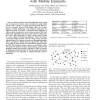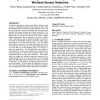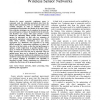694 search results - page 85 / 139 » Energy Efficient Schedulers in Wireless Networks: Design and... |
122
click to vote
SENSYS
2006
ACM
15 years 5 months ago
2006
ACM
Sensor networks exhibit a unique funneling effect which is a product of the distinctive many-to-one, hop-by-hop traffic pattern found in sensor networks, and results in a signific...
TPDS
2008
14 years 11 months ago
2008
Communication is a primary source of energy consumption in wireless sensor networks. Due to resource constraints, the sensor nodes may not have enough energy to report every readin...
100
click to vote
TMC
2008
14 years 11 months ago
2008
Recent research shows that significant energy saving can be achieved in wireless sensor networks by using mobile elements (MEs) capable of carrying data mechanically. However, the ...
102
click to vote
SENSYS
2003
ACM
15 years 5 months ago
2003
ACM
An effective approach for energy conservation in wireless sensor networks is scheduling sleep intervals for extraneous nodes, while the remaining nodes stay active to provide cont...
115
click to vote
JCP
2008
14 years 11 months ago
2008
In sensor networks, continuous query is commonly used for collecting periodical data from the objects under monitoring. This sort of queries needs to be carefully designed, in orde...



